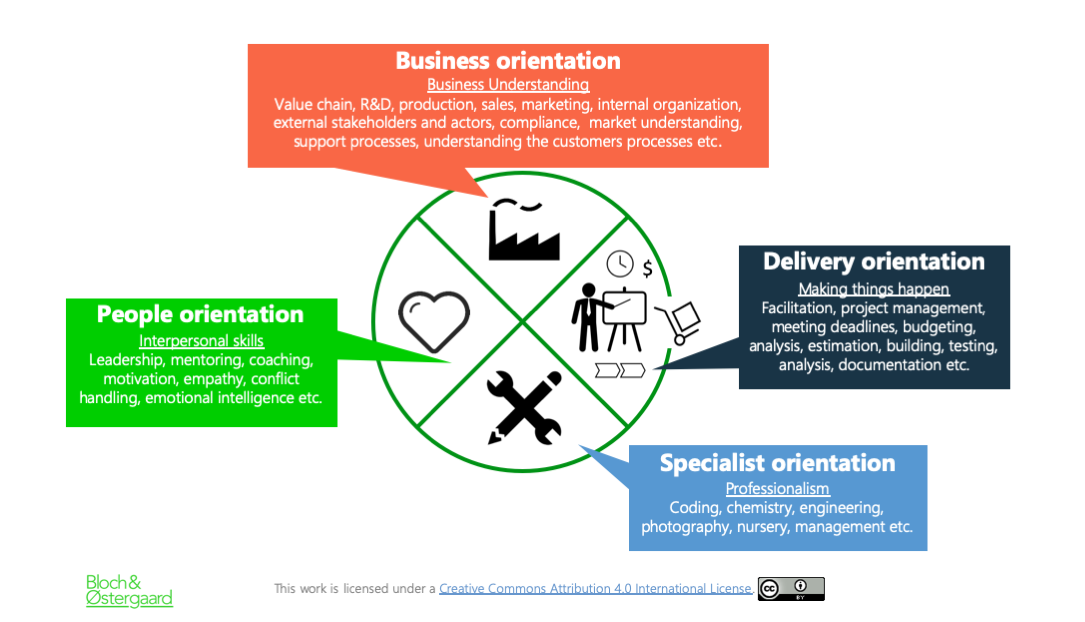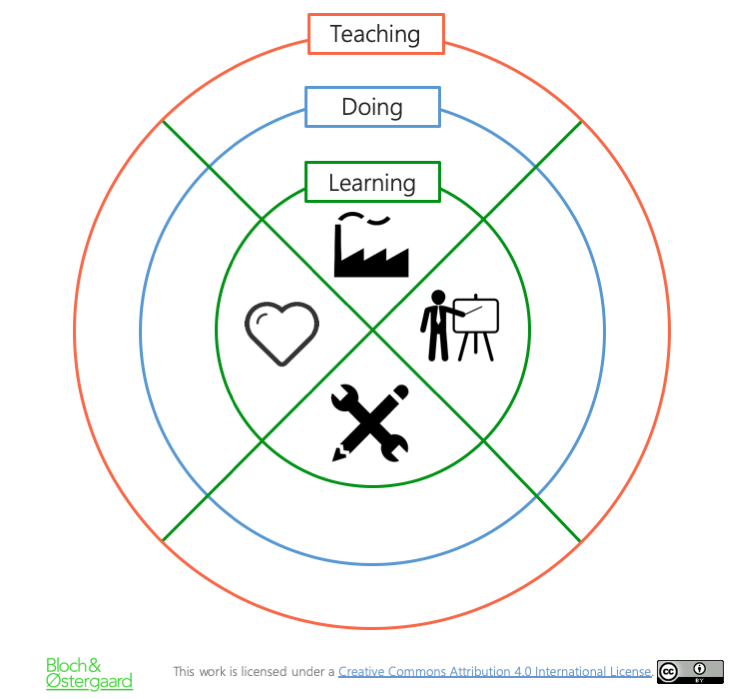Tool: The Pizza Model
By Arbresh Useini, 9. December 2018
This tool – with a very original name – can be used in many different ways, when you are leading a team, creating teams-of-teams, looking at new organizational structures or having regular one-to-ones. The Pizza Model helps you create a simple division between roles and tasks, as well as guiding you about capabilities and skills.
In this post we’ll describe the tool for you. First an introduction to the four pizza slides. Secondly how you can use the model to improve competences. Thirdly how you can use it when delegating tasks, and finally how to solve problems using the Pizza Model.
How to use the ‘Pizza Model’ in your organization
The ‘Pizza Model’ shows four areas, that describe the components of roles in an organization. First we’ll describe these roles and orientations, then you can download the tool and read more ways to use it in your team and organization.
The four orientations in the Pizza Model:
- The Business orientation, focusing on business understanding, vision and strategy. One must understand why and how the business is moving. To understand the value chain, R&D, production, marketing, internal and external actors, processes etc. is an inevitable part of this orientation.
- The People orientation, focusing on personal and interpersonal skills. It involves both coaching and mentoring, which again can be divided into both micro and macro coaching/mentoring. Factors such as emotional intelligence, conflict handling and motivation are natural entities in this area. Towards the employee, the manager has the responsibility to ensure daily support and instruction regarding the tasks and the handling of those.
- The Delivery orientation, focusing on processes, products, and projects, and all related elements of getting things done. Particularly delivery managers must focus on this, on facilitation and on project managing. Building, testing and analysis are inevitable elements in this orientation.
- The Specialist orientation, focusing on professional skills for craftsmanship. The specialist orientation is from a leader’s perspective to respect and cultivate the professionalism of the teams. Delegating tasks in teams also is about trusting the specialist orientation – and understanding when the employees are better skilled than the manager.
Managers have all four orientations as her responsibility: She understands what business she’s in, is responsible for delivering the products, has the necessary skills at hand, and is responsible for the employees in her business unit.
Improving competences with the Pizza Model
Use the model to map and develop employee competencies, capabilities and skills. What are you good at? Where do you need to learn? And where can you teach others your skills? Through regular dialogues you as a leader can understand where the employee feels they should improve.
Divide the circle intro three levels:
- Learning, the employee is in learning mode. From here he needs to move into the ‘doing’ level.
- Doing, when the employee masters the skill, and practices it regularly with success.
- Teaching, when the employee masters it at a level, that they can teach others.
Now, map in all tasks and skills in each pizza slide.
- You will most likely have skills in learning, doing or teaching levels, for each pizza slide
- And you will most likely have two pizza slices, where you feel most at home.
- Now, make a plan for where you want to develop: Create two goals that you can reach within two months. Should you strengthen a skill in ‘learning mode’? Should you be a teacher for someone?
Each step indicates at which level the employees is at regarding each pizza slide. It is your responsibility to make sure the employee can move to the next level.
Next step: delegate, delegate, delegate
Distributed leadership creates a bubbly development in your organization and increases creativity, productivity and efficiency. Also, teams-of-teams automatically implies delegating tasks.
You can take the following steps:
- Make a list of all your tasks and the decisions you have.
- Find out if the tasks and decisions are the right places, that is, if the employees and colleagues have the right skill set to handle it – use the ‘Pizza Model’ to this.
- Offer the tasks to those who have the willingness, time, and skill to run with them.
- Be sure to capture misunderstandings or erroneous assumptions by having frequent touch-points between you, with briefing on progress, etc.
One must understand that delegating is based on a mix of needs from the project and the employees wishes, handled as a collaboration between the manager and the employee. This means, that the tasks and the pizza slices of the model are distributed to the team-of-teams, managed by the manager.
More than often an employee or manager typically prefers only two of the four pizza slices. This means, that having the option to distribute the leadership tasks and consequently re-aligning personal preferences with the newly emerged roles is a relief to some. They get released from the tasks, that they don’t feel skilled for or like, and gains new traction and well-being in their new role.
Solve problems with the model
You can also use the tool the other way around, starting with a project or a problem to solve.
In October we held a Hacktober, trying to hack future problems. We used the ‘Pizza Model’, to find out, who in our organizations are capable of handling potential future problems as well as where we need to increase focus to handle the potential problems.
When solving a problem, the model can be used to understand which capabilities are needed to solve it.
Start by asking four questions:
- Which problems do we want to resolve?
- Who does it affect?
- What happens if we don’t solve this problem?
- What happens if we solve it?
Look at the four orientations from the model and which orientations will be affected by the problem or is useful to solve it. Afterwards assess who in the organization has the
capabilities to solve the problem.
Are you looking for
a coach or
a professional mentor?
Looking for a thought-provoking speaker
with knowledge of the future
and how to turn it into daily life?
Do you want to make a deep dive?
Visit our learning paths with the
newest content – it’s all free!








